What should a “right” PULL incentive for Europe look like? The concept has been discussed for some time now. From numerous published reports and articles, as well as the two recent pilot studies conducted in Sweden and England, we are now able to draw up a list of important criteria for the mechanism to be effective.
Delinking revenues from sales
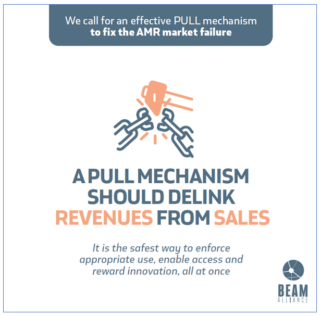 The correlation between revenue and sales volume has several deleterious effects for antimicrobials:
The correlation between revenue and sales volume has several deleterious effects for antimicrobials:
- It creates an incentive to sell more than necessary, which runs counter to the principles of appropriate use
- It de-prioritises marketing in territories with small target populations, making access for patients most in need almost impossible
- It does not guarantee sufficient revenues to justify significant R&D expenditure to develop new products
This is why a PULL mechanism should delink revenues from sales. In this way:
- Sales are not forced, ensuring more appropriate use
- All territories can be attractive once again and thus gain access to important antimicrobials
- Sufficient revenues can be drawn, allowing the recouping of R&D investments.
Seeking rapid implementation
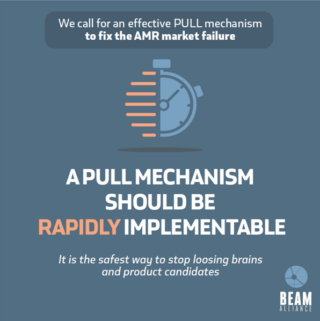 The entire AMR innovation ecosystem is committed to fighting AMR by developing new products. However, because of the market failure, SMEs are struggling in raising the funds necessary to carry out R&D activities.
The entire AMR innovation ecosystem is committed to fighting AMR by developing new products. However, because of the market failure, SMEs are struggling in raising the funds necessary to carry out R&D activities.
SMEs have a survival horizon that is often measured in months, jeopardising the already meagre product development portfolio.
Such a situation also discourages talented scientists, who prefer to move on to more promising healthcare fields.
Urgent action is needed to preserve this ecosystem and enable it to flourish again.
Matching the time cycle of policymaking with the constraints of the biotech business model is a critical issue.
If the solution comes too late, the ecosystem will have to be rebuilt from scratch. This will take time. And a lot of resources.
This is why a PULL incentive should be rapidly implementable.
Profiling size and predictability
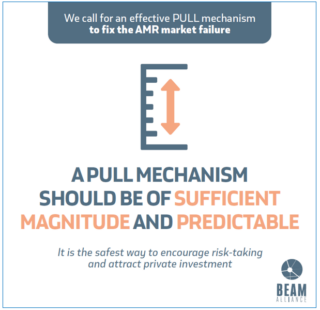
The problem at the heart of the market failure is that the revenues generated by a new antimicrobial do not recoup the R&D investment.
As long as this equation is out of balance, it is impossible to have a fully functioning innovation engine.
This is why a PULL mechanism should be of sufficient magnitude to bring things back into balance.
But the drug developer and its investors must also be convinced that the game is worth the candle when the financial risks become significant.
This is why both the magnitude of the reward and the eligibility for it should be known as soon as the clinical phases are launched.
Rewarding patient utility first
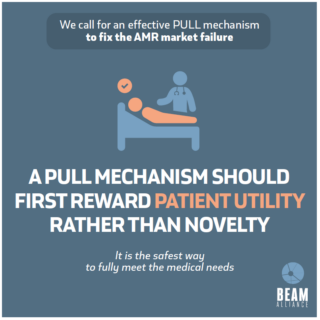 Much emphasis has been placed on the need for radically new antimicrobials.
Much emphasis has been placed on the need for radically new antimicrobials.
On paper, the novelty is intended to mitigate the risk of rapid emergence of resistance.
But the lack of discovery of new classes for decades probably shows that the low hanging fruits have already been picked.
It is important not to be too dogmatic: ‘new’ does not always mean ‘better’, and the race to radically new products will be increasingly difficult.
This is why a PULL mechanism should concentrate first and foremost on rewarding patient utility and use novelty as a secondary measure.
Rewarding also product improvements
 In line with the need to target patient utility, it is important that product development is not driven by speed, but by quality. Not by ease, but by rigour.
In line with the need to target patient utility, it is important that product development is not driven by speed, but by quality. Not by ease, but by rigour.
To encourage safe and effective product development, one cannot reward on a ‘first-come, first-served’ basis.
It is not about rewarding me-too products, but also 2nd-in-class products with significantly better properties than their predecessors.
This is why a PULL mechanism should not reward only 1st-in-class products.
Proposing realistic guardrails
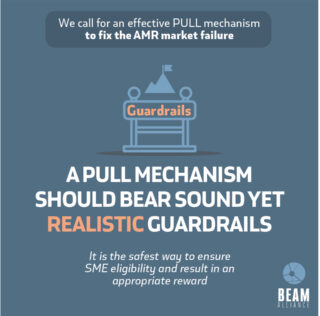 Most PULL incentive models require the use of guardrails.
Most PULL incentive models require the use of guardrails.
These guardrails are important to keep the mechanics running smoothly and to avoid any overflow.
Nevertheless, one must keep in mind that most of the products under development are currently carried by SMEs. As such, it is likely that some of the future products to come onto the market will be marketed by SMEs.
If certain safeguards are impossible for SMEs to achieve, it means that their products will not reach the market. At the expense of patients.
This is why a PULL mechanism should bear sound yet realistic guardrails.

